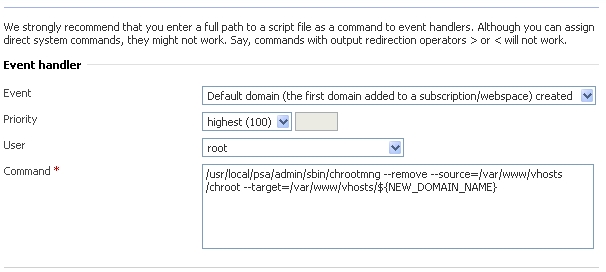I haven’t found the way how to disable creating chroot-folders on webspace with new domain creation.
So, on Parallels forum support offered me to create Event manager handler.
Open Plesk -> Tools & Settings -> Event Manager -> Add New Event Handler
Fill the form:
Event:
Default domain (the first domain added to a subscription/webspace) created
Priority:
highest (100)
User:
root
Command:
/usr/local/psa/admin/sbin/chrootmng –remove –source=/var/www/vhosts/chroot –target=/var/www/vhosts/${NEW_DOMAIN_NAME}
This handler will remove chroot from newly created domain immediately.

You can disable it by setting the following environment variable prior to the installation
or upgrade:
export PLESK_QUOTACHECK_OFF=1
Of course this will work only if you run the process in the same shell, thus, it can’t be
set for GUI upgrader.
KB Parallels: During an installation/upgrade file system quotas check takes way too much time, can I disable it?.
September 30th, 2011
alex
Only one right silution: to add timeout for 1ms before destroying the jQuery UI’s draggable/selectable
Source: Bug on destroying jQuery UI’s selectable. | Lost in IT world.
September 29th, 2011
alex
September 16th, 2011
alex
Great software!
Why PHPTracker? Because it’s not “just a tracker”, it contains a seeder server too so the distribution of your files is automatic. This is a big step for the content providers to adapt this amazing technology and change the stereotype that “torrent = warez”.
PHP based torrent file creator, tracker and seed server – PHPTracker.
Symptoms
Real memory usage reported by Plesk Health Monitoring Service (Home > Server Health > Memory) does not match RAM reported by utility ‘free‘.
Cause
RAM was updated after Parallels Plesk Panel was installed.
Plesk Health Monitor does not detect if the system configuration was changed after the initial installation.
Resolution
The problem will be fixed in future update of Parallels Plesk Panel that will be released after version 10.2.
To workaround:
# /usr/local/psa/bin/sw-engine-pleskrun /usr/local/psa/admin/plib/scripts/setup-health-monitor.php
ffmpeg-php – error: ‘PIX_FMT_RGBA32’ undeclared (first use in this function) | HOW GEEK!.
/root/install/ffmpeg-php-0.6.0/ffmpeg_frame.c: In function 'zim_ffmpeg_frame_toGDImage':
/root/install/ffmpeg-php-0.6.0/ffmpeg_frame.c:336: error: 'PIX_FMT_RGBA32' undeclared (first use in this function)
/root/install/ffmpeg-php-0.6.0/ffmpeg_frame.c:336: error: (Each undeclared identifier is reported only once
/root/install/ffmpeg-php-0.6.0/ffmpeg_frame.c:336: error: for each function it appears in.)
/root/install/ffmpeg-php-0.6.0/ffmpeg_frame.c: In function 'zim_ffmpeg_frame_ffmpeg_frame':
/root/install/ffmpeg-php-0.6.0/ffmpeg_frame.c:421: error: 'PIX_FMT_RGBA32' undeclared (first use in this function)
make: *** [ffmpeg_frame.lo] Error 1
To fix this, replace PIX_FMT_RGBA32 with PIX_FMT_RGB32 .
You can use “rpl” to replace files recursively:
cd to the ffmpeg-php folder and run this command (beware!):
rpl -R PIX_FMT_RGBA32 PIX_FMT_RGB32 *
If rpl not installed on your system, install it, for example:
yum install rpl
I’ve coded small function that allows filter user input to <input> fields.
It allows to press 0-9 keys (incl. NumPad keys), “,” and “.”, Backspace.
It’s enought to write float value.
$(':input.onlynum').keypress(function(event) {
if (
// numbers
(event.which < 48 || event.which > 57) &&
// .,
event.which != 44 && event.which != 46 &&
// backspace
event.which != 8
) {
event.preventDefault();
return;
}
})
HTML:
Try to input non-numeric symbols:
<input class="onlynum">
